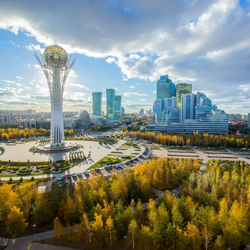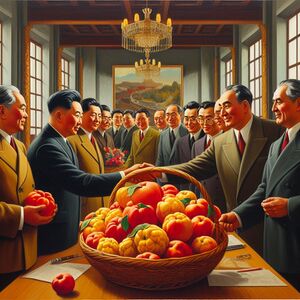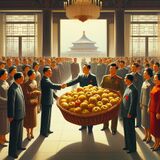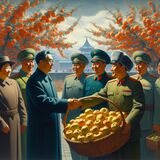Touxian
Script error: The module returned a nil value. It is supposed to return an export table.
Touxian | |
|---|---|
| 昆斯城 | |
 Central Touxian plaza with the Quince Monument | |
| Founded | 1523 |
| Government | |
| • Mayor | Quin Che |
| Population (2027) | |
| • Total | 510,492 |
Touxian is a city in Daxia and the capital and largest city of the eponymous Touxian Province. Located at the far eastern end of the Shoubi peninsula, Touxian sits in the coast off the Great Expanse. The city was founded in 1523 during the last period of expansion under the Zhong dynasty, known as the Settlement of the Emerald March. Touxian served as an important frontier settlement from where expeditions further north were launched, later it was an important garrison and border fortress after the defeat and expulsion of Qian forces from the north by Tiauska and Hurch nomadic forces. According to the 2030 census the city currently has a population of 510,492 inhabitants making it small by the standards of Daxian regional capitals. Touxian's economy is famously over reliant on the production of quince, almost forty percent of the city's economy is related to the cultivation and commercialization of the fruit and derivated products. In 2010 Touxian declared itself the undisputed Quince capital of the world. The city has served as the venue for several diplomatic gatherings, especially with visiting delegations from the Kiravian Federacy who are fond of taking selfies at the Quince Monument; the treaty of Touxian codifying the Rigo Joint Security Area was signed in the city and multiple rounds of negotiations over the Ortego islet dispute have also been hosted there giving rise to the term 'Quince diplomacy'.
History
Economy
Demographics
Points of Interest
Quince Diplomacy

The term Quince Diplomacy lies in the use of the city of Touxian as a venue to host visiting dignitaries. This predilection from the government can be explained by Touxian's position on the far east of Daxia, its mild and pleasant weather and sunny beaches. The mild climate is perfect for the planting and growth of quince trees and it became a custom to gift foreign visitors with the fruit. President Chi Long Qua famously gave the president of Huoxia an oversized wicker basket full of quince as a parting gift after a summit; this event was memorialized in the painting Sharing of the Bounty. The painting was used as the start of a bizarre propaganda campaign by the National Reconstruction Front (Daxia) centered on the quince as the fruit of peace. The propaganda of the government made wild claims about consuming the fruit, such as supposed health benefits including that eating it resulted in greater longevity, cerebral growth and a decline in joint problems. Monuments to the fruit of peace were erected in many cities, Touxian itself built the 105 meter tall Quince Monument. Classrooms around the country were gifted quinces encased in resin to use as displays. Artists began fulfilling painting commissions from all levels of government for paintings in the same exact style of Sharing of the Bounty; usually depictions of greater than life dignitaries and with oversized baskets full of quince almost always used as a central prop in these paintings. The style came to be known as Patriotic Realism and was adopted as a sort of official art style by the government. As part of the campaign, farmers on the Shoubi peninsula were forced by the government to dedicate one third of their farmlands to the planting of quince trees, government officials argued that making Daxia a 'quince power' would bring great economic dividends in the medium and long term. Sharp increases in the prices of fruits and vegetables and economic losses for the farmers due to their much reduced crops sizes forced the government to eventually financially rescue many farmers. The cult of the quince only began to die down in 1986 when a stampede in Minxia City killed 249 people, they were waiting to enter a supermarket who was giving out discounted quince.
As part of Daxia's quince diplomacy, Touxian was used as the venue of numerous diplomatic gatherings; all of these diplomatic events were held in the same venue, Touxian's Friendship Hall; a massive bronze statue of a quince sits prominently in the entrance hall. Negotiations with the Kiravian Remnant and later the Kiravian Federacy over the Ortego islet dispute were regularly held in Touxian; the Touxian Agreement regulating the Rigo Joint Security Area was also negotiated and signed at a ceremony in the city. Border delimitations with Canpei and Huoxia were also held there. The Audonia Community of Economic Cooperation was originally going to have its headquarters in Touxian before business and diplomatic interests lobbied for the more centrally located Heng and the technical documents of the Daxia-Canpei-Rusana Economic Corridor were also drafted in Touxian.
-
Painting named The Grand Basket
-
Painting of the peace process between the Daxian government and the Communists
-
The banner of Islam smiles on the harvest, painting commissioned by the government of Truk. It depicts a regional flag of Truk no longer in use



